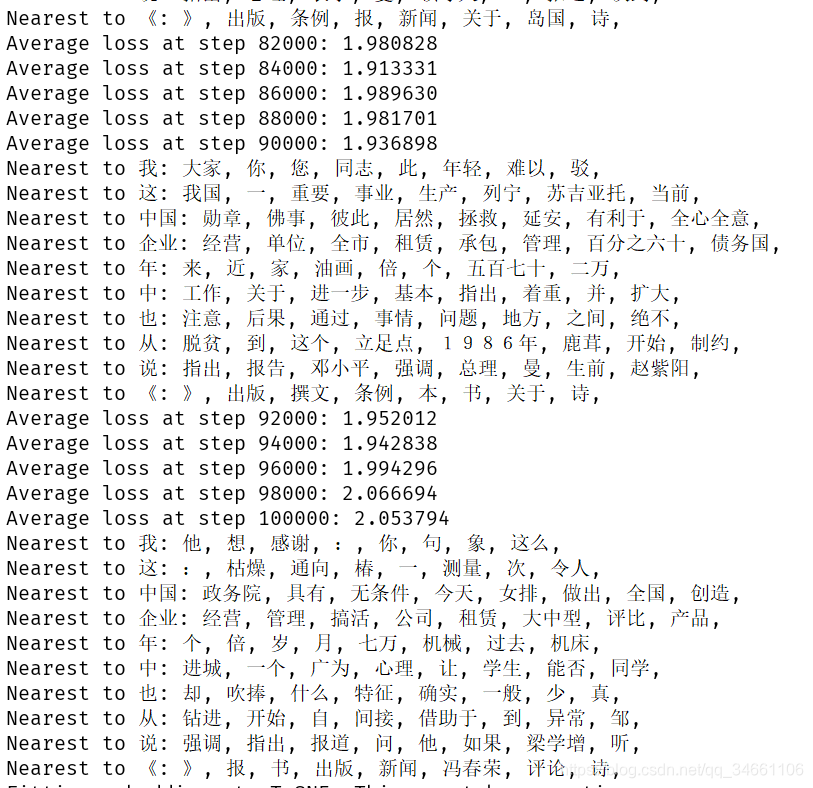本文参考tensorflow自然语言处理书上的skip gram加以实现
skip gram:word_list -> embedding -> softmax(embedding) -> optimize loss -> select the best embedding & weight & bias
主要思路:
1.给出一批数据,求出在给定window_size下的目标词和上下文词组合,在本代码中,train_dataset即target word的集合,labels即为上下文word
2.初始化embedding(根据train_dataset找出所对应的embedding),初始化权重,初始化偏置
3.根据损失函数和优化器不断优化embedding、权重和偏置,即目的在于寻找词的最佳embedding
4.计算词的相似度,在本代码中,挑选了10个高频率词和10个低频率词作为valid_dataset,根据该valid_dataset找出所对应的embedding,计算相似度,再根据该相似度找出这20个词各自对应的相似度较高的词,最后根据不断优化的embedding不断计算相似度。
注意:
另外本文数据采用的是人民日报1998数据,有需要的私信我哦。
该代码无法生成图,因为pylab.cm.spectral这个包不存在,可能是版本变化,所以有知道怎么办的童鞋可以交流一下哈。
如果要成为一个模型主要就是训练出各个词所对应的embedding,然后根据该embedding进行一系列操作即可。
结果如下:效果感觉一般。。。。

from matplotlib import pylab
import tensorflow as tf
import collections
import math
import numpy as np
import os
import random
import bz2
from six.moves import range
from six.moves.urllib.request import urlretrieve
from sklearn.cluster import KMeans
import operator
import csv
import os
from sklearn.manifold import TSNE
from math import ceil
import spectral# https://www.evanjones.ca/software/wikipedia2text.tar.bz2
class Skip_gram:def __init__(self):self.url = 'http://www.evanjones.ca/software/'self.word_list = []self.voca_size = 20000self.data_index = 0self.batch_size = 128self.embedding_size = 128self.window_size = 4self.valid_size = 10self.valid_window = 50#从0-50中随机采样10个数据self.valid_examples = np.array(random.sample(range(self.valid_window),self.valid_size))#再从1000-1050中采样10个数据 #结果如[ 46 17 16 19 34 41 2 4 43 28 1016 1035 1002 1005 1024 1034 1037 1041 1032 1028]self.valid_examples = np.append(self.valid_examples,random.sample(range(1000,1000+self.valid_window),self.valid_size),axis=0)def maybe_download(self,filename,expected_bytes):if not os.path.exists(filename):print('Downloading file')filename,_ = urlretrieve(self.url + filename,filename)statInfo = os.stat(filename)if statInfo.st_size == expected_bytes:print('Found and verified %s' % filename)else:print(statInfo.st_size)raise Exception('Failed to verify ' + filename + '. Can you get to it with a browser?')return filenamedef read_data(self,filename):for line in open(filename,encoding='utf8'):if line:sub_word_list = line.split(' ')for word in sub_word_list:if word not in ['\n',',','“','”','、','。',',','的','了','在','和','有','是']:self.word_list.append(word)#dictionary:{voca1:0,voca2:1,voca3:2}#reverse_dictionary:{0:voca1,1:voca2,2:voca3}#count:{voca1:2,voca2:3,voca3:5}#data:Contains the string of text we read.where string words are replaced with word IDsdef build_dataset(self,words):count = [['UNK',-1]]count.extend(collections.Counter(words).most_common(self.voca_size-1))word_dictionary = dict()for word,_ in count:word_dictionary[word] = len(word_dictionary)data = list()unk_count = 0#常用单词用自己的索引#不常用单词用UNK索引(0)for word in words:if word in word_dictionary:index = word_dictionary[word]else:index = 0unk_count = unk_count + 1data.append(index)count[0][1] = unk_countreverse_dictionary = dict(zip(word_dictionary.values(),word_dictionary.keys()))assert len(word_dictionary) == self.voca_sizereturn data,word_dictionary,reverse_dictionary,countdef generat_batch_skip_gram(self,batch_size,window_size):#存储target wordbatch = np.ndarray(shape=(batch_size),dtype=np.int32)#用于存储上下文 wordlabel = np.ndarray(shape=(batch_size,1),dtype=np.int32)#上下文单词数量+target wordspan = 2*window_size+1#用于存储在span中的所有word的索引,包括targetbuffer = collections.deque(maxlen=span)for _ in range(span):buffer.append(data[self.data_index])self.data_index = (self.data_index+1)%len(data)#为单个target word所需采样的上下文word数量num_sample = 2 * window_size#把batch的读取分为两个循环#内循环负责用span中num_sample数量的data填充labels和batch#外循环负责重复batch_size//num_sample次这个过程产出完成的batchfor i in range(batch_size//num_sample):k=0#target word不作为预测for j in list(range(window_size)) + list(range(window_size+1,2*window_size+1)):#存储target word#[0,1,2,3,target word,5,6,7,8]#batch[0] = buffer[4] batch[1] = buffer[4]batch[i*num_sample + k] = buffer[window_size]#label[0...7] = buffer[1,2,3,4]和buffer[5,6,7,8]即tarword的上下文单词label[i*num_sample + k,0] = buffer[j]k += 1#存储完一个span,span(buffer)向右移动一个单位,因为span(buffer)是一个deque,即双向队列#且上面设置其最大长度为9,再添加一个元素,则队首出队,新元素加入队尾#即span由[0,1,2,3,4,5,6,7,8] 变为 [1,2,3,4,5,6,7,8,9] 此时的target word则变成了5#故每一个batch有16个target word 对应128个 context wordbuffer.append(data[self.data_index])self.data_index = (self.data_index + 1) % len(data)return batch,labeldef skip_gram(self):tf.reset_default_graph()train_dataset = tf.placeholder(tf.int32, shape=[self.batch_size])train_labels = tf.placeholder(tf.int32, shape=[self.batch_size, 1])valid_dataset = tf.constant(self.valid_examples, dtype=tf.int32)#初始化embeddingembeddings = tf.Variable(tf.random_uniform([self.voca_size, self.embedding_size], -1.0, 1.0))#初始化softmax的权重,注意的是softmax就是将原来得到的值映射到[0,1]区间,也可以看作为概率值#根据此进行分类和预测#算法流程为:词经过嵌入层后变为词向量,再经过softmax函数进行预测和分类得到预测值a,#logits = wx + b(在本代码里就是随机初始化了embedding向量,再进行优化) softmax(logits) --> a#根据交叉熵的作为损失函数 Loss=-Σy*lna,优化权重 y为真实值, a为经过softmax后的预测值softmax_weights = tf.Variable(tf.truncated_normal([self.voca_size, self.embedding_size],stddev=0.5 / math.sqrt(self.embedding_size)))softmax_biases = tf.Variable(tf.random_uniform([self.voca_size], 0.0, 0.01))#tf.nn.embedding_lookup函数的用法主要是选取一个张量里面索引对应的元素#用train_dataset寻找embedding里的张量embed = tf.nn.embedding_lookup(embeddings, train_dataset)num_sampled = 2*self.window_size#定义损失函数loss = tf.reduce_mean(tf.nn.sampled_softmax_loss(weights=softmax_weights, biases=softmax_biases, inputs=embed,labels=train_labels, num_sampled=num_sampled, num_classes=self.voca_size))#计算minibatch和all embeddings 之间的相似度,用余弦距离#规范化因子norm = tf.sqrt(tf.reduce_sum(tf.square(embeddings), 1, keepdims=True))normalized_embeddings = embeddings / normvalid_embeddings = tf.nn.embedding_lookup(normalized_embeddings, valid_dataset)similarity = tf.matmul(valid_embeddings, tf.transpose(normalized_embeddings))#优化optimizer = tf.train.AdagradOptimizer(1.0).minimize(loss)num_steps = 100001skip_losses = []# ConfigProto is a way of providing various configuration settings# required to execute the graphwith tf.Session(config=tf.ConfigProto(allow_soft_placement=True)) as session:# Initialize the variables in the graphtf.global_variables_initializer().run()print('Initialized')average_loss = 0# Train the Word2vec model for num_step iterationsfor step in range(num_steps):# Generate a single batch of databatch_data, batch_labels = self.generat_batch_skip_gram(self.batch_size, self.window_size)# Populate the feed_dict and run the optimizer (minimize loss)# and compute the lossfeed_dict = {train_dataset: batch_data, train_labels: batch_labels}_, l = session.run([optimizer, loss], feed_dict=feed_dict)# Update the average loss variableaverage_loss += lif (step + 1) % 2000 == 0:if step > 0:average_loss = average_loss / 2000skip_losses.append(average_loss)# The average loss is an estimate of the loss over the last 2000 batches.print('Average loss at step %d: %f' % (step + 1, average_loss))average_loss = 0# Evaluating validation set word similaritiesif (step + 1) % 10000 == 0:sim = similarity.eval()# Here we compute the top_k closest words for a given validation word# in terms of the cosine distance# We do this for all the words in the validation set# Note: This is an expensive stepfor i in range(self.valid_size):valid_word = reverse_dictionary[self.valid_examples[i]]top_k = 8 # number of nearest neighborsnearest = (-sim[i, :]).argsort()[1:top_k + 1]log = 'Nearest to %s:' % valid_wordfor k in range(top_k):close_word = reverse_dictionary[nearest[k]]log = '%s %s,' % (log, close_word)print(log)skip_gram_final_embeddings = normalized_embeddings.eval()# We will save the word vectors learned and the loss over time# as this information is required later for comparisonsnp.save('skip_embeddings', skip_gram_final_embeddings)with open('skip_losses.csv', 'wt') as f:writer = csv.writer(f, delimiter=',')writer.writerow(skip_losses)num_points = 1000tsne = TSNE(perplexity=30,n_components=2,init='pca',n_iter=5000)print('Fitting embeddings to T-SNE. This can take some time ...')selected_embeddings = skip_gram_final_embeddings[:num_points,:]two_d_embeddings = tsne.fit_transform(selected_embeddings)print('Pruning the T-SNE embeddings')# prune the embeddings by getting ones only more than n-many sample above the similarity threshold# this unclutters the visualizationselected_ids = self.find_cluster_embeddings(selected_embeddings, .25, 10)two_d_embeddings = two_d_embeddings[selected_ids, :]print('Out of ', num_points, ' samples, ', selected_ids.shape[0], ' samples were selected by pruning')# words = [reverse_dictionary[i] for i in selected_ids]# self.plot(two_d_embeddings,words)def find_cluster_embeddings(self,embeddings,distance_threshold,sample_threshold):consine_sim = np.dot(embeddings,np.transpose(embeddings))norm = np.dot(np.sum(embeddings ** 2, axis=1).reshape(-1, 1),np.sum(np.transpose(embeddings) ** 2, axis=0).reshape(1, -1))assert consine_sim.shape == norm.shapeconsine_sim /= normnp.fill_diagonal(consine_sim,-1,0)argmax_cos_sim = np.argmax(consine_sim,axis=1)mod_cos_sim = consine_simfor _ in range(sample_threshold - 1):argmax_cos_sim = np.argmax(consine_sim, axis=1)mod_cos_sim[np.arange(mod_cos_sim.shape[0]), argmax_cos_sim] = -1max_cosine_sim = np.max(mod_cos_sim, axis=1)return np.where(max_cosine_sim>distance_threshold)[0]def plot(self,embeddings, labels):n_clusters = 20 # number of clusters# automatically build a discrete set of colors, each for clusterlabel_colors = [pylab.cm.spectral(float(i) / n_clusters) for i in range(n_clusters)]assert embeddings.shape[0] >= len(labels), 'More labels than embeddings'# Define K-Meanskmeans = KMeans(n_clusters=n_clusters, init='k-means++', random_state=0).fit(embeddings)kmeans_labels = kmeans.labels_pylab.figure(figsize=(15, 15)) # in inches# plot all the embeddings and their corresponding wordsfor i, (label, klabel) in enumerate(zip(labels, kmeans_labels)):x, y = embeddings[i, :]pylab.scatter(x, y, c=label_colors[klabel])pylab.annotate(label, xy=(x, y), xytext=(5, 2), textcoords='offset points',ha='right', va='bottom', fontsize=10)# use for saving the figure if needed# pylab.savefig('word_embeddings.png')pylab.show()if __name__ == '__main__':filename = 'C:/Users/dell/Desktop/WordSegment-master/data/train.txt'sg = Skip_gram()sg.read_data(filename)# print(len(sg.word_list))data,word_dictionary,reverse_dictionary,count = sg.build_dataset(sg.word_list)# batch,label = sg.generat_batch_skip_gram(8,1)sg.skip_gram()